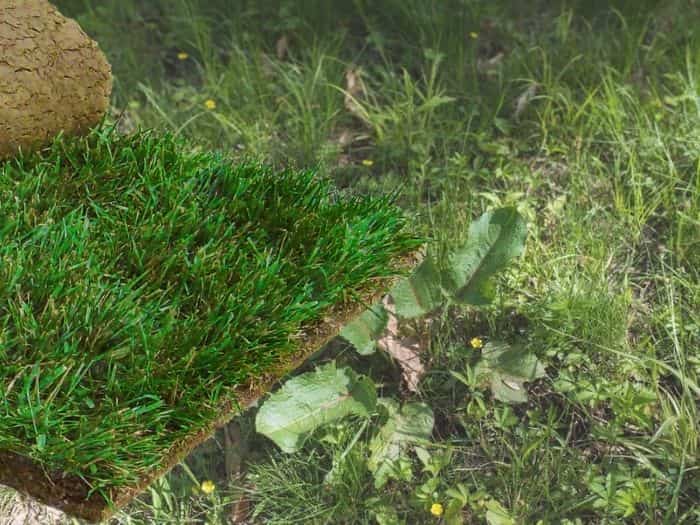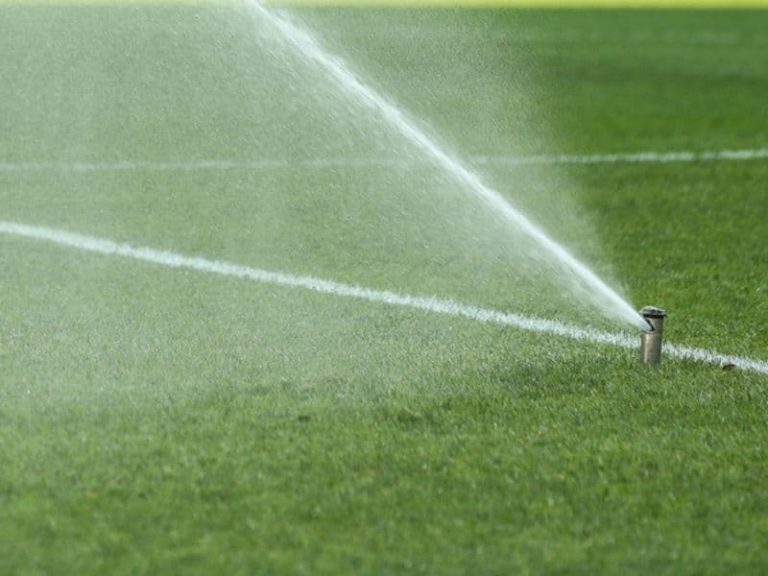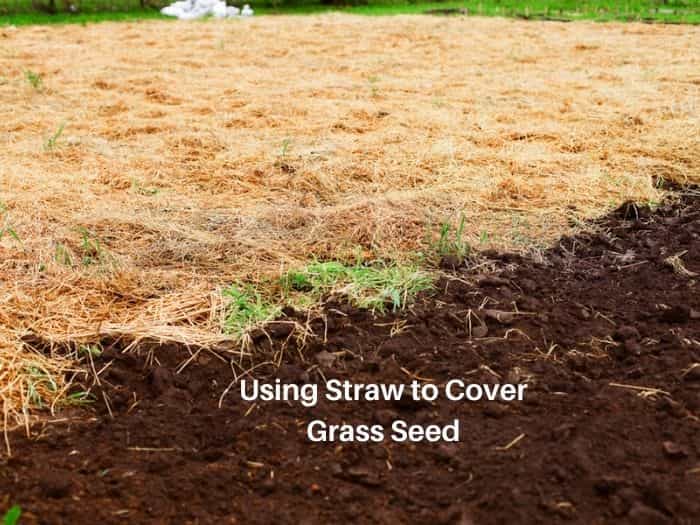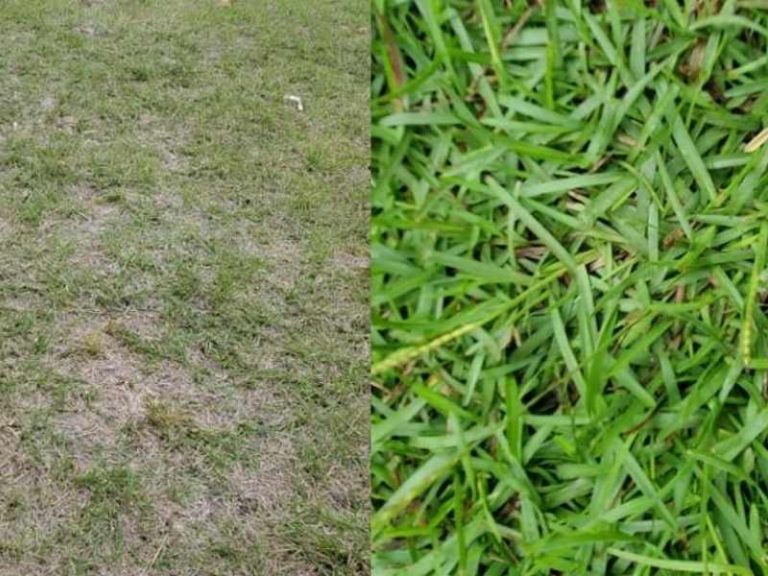Can You Lay Sod Over Weeds? [How to Sod a Weedy Area]
Before planting grass, you’ll first need to get rid of weeds and till and prepare the soil. It will also take some time for the lawn to be fully established. But, you can opt to lay sod for quicker results. But the question is: can you lay sod over weeds? Do you need to kill the weeds first?
You should NOT lay sod over weeds because the weeds will act as a barrier between the soil and the grass roots, preventing contact and causing poor root establishment. Weeds can also grow through sod spaces and infest the lawn. Kill the weeds first, till the soil, and then lay new sod.
I’ve answered this question in detail below – and much more – including a detailed explanation on what happens when you install new sod over weeds- as well as the proper procedure for prepping a weedy lawn for sodding.
Can you lay sod over weeds?

No, you should avoid installing new sod over a weedy lawn. In fact, you should take all the necessary steps to ensure that you completely rid your lawn of weeds before planting new sod. Weeds will still grow through the sod, consequently diminishing your curb appeal and necessitating frequent weeding.
What happens when you put sod over weeds?
When you lay new sod over a weedy lawn, the weeds will grow and penetrate through the sod pieces, breaking the solid green visual pattern on your lawn. A weed-laden lawn is usually unsightly to look at.
Weeds also compete for important soil nutrients with your growing turfgrass, consequently affecting the health of the turf. Since new sod is usually fragile due to shallow root systems and poor contact with the soil, their health and growth is likely to be heavily hampered by presence of weeds on the lawn.
Some weeds also grow tall and with wide leaves that shadow the grass below them. With some of the spots being denied sunlight exposure due to taller weed plants, you end up with brownish and yellow spots in the lawn.
What if the weeds are dead?
Should you lay sod over weeds if the weeds are dead?
The answer is no, it is not recommended to lay sod over dead weeds. Mature weeds may be dead but the seeds are still in the soil and will germinate soon enough leading to a weed-infested lawn.
Scalping or mowing too low prior to sodding with new turfgrass will also not solve your weed problems. Weed seeds may still be present beneath the soil and will sprout later on once you install your sod.
What’s more, the dead weed clippings left on the lawn after mowing act as a barrier between the sod pieces and the topsoil, consequently preventing proper sod-topsoil contact and root development. Therefore, to facilitate proper root anchorage for your newly-installed sod, you should rake up all dead weeds and their clippings that you’ve mowed off the lawn prior to laying the sod.
How to Prepare a Weedy Area for Sodding
Proper lawn preparation for sodding entails elimination of all invasive weeds present on the lawn. To effectively prepare a weedy area for sodding and prevent re-appearance of invasive weeds in the future, we recommend following the procedure detailed below:
1. Apply a weed killer
To quickly rid your lawn of weeds before sodding, chemical-based herbicides containing glyphosate are your best bet, as they kill invasive grasses and broadleaf weeds all the way down to the roots. You can also opt for a highly effective pre-emergent and post-emergent combo such as Tenacity Turf Herbicide that will kill weeds and prevent the seeds from germinating.
The good thing about herbicide-application on a bare lawn that you’re looking to re-sod is that you don’t have to worry about killing any desirable turfgrass. As such, you can apply the weed-killer solution/chemical indiscriminately.
However, if you’re concerned about the environmental impact of such chemical herbicides, you can opt- instead- for an organic weed-killer such as vinegar, baking soda, and dish soap solution.
Whether you’re using a chemical or organic weed killer, you should give the herbicide about a week to effectively get rid of all the weeds before laying your sod.
2. Treat the lawn again
The initial treatment might not be enough to fully get rid of tough weeds such as crabgrass as most herbicides only kill weed plants- but not the seeds. As such, don’t be surprised to see new weed sprouting on your lawn about 7-14 days after the initial application of herbicide as per step one above. If you notice this, it’s advisable to spray the lawn again with a good-quality chemical or organic herbicide.
Alternatively, you can get rid of stubborn weed seeds that are buried beneath the soil by solarization. This means covering the entire lawn with builders-grade transparent plastic. You can ensure that the plastic covering stays in place by holding down the edges with stone, bricks, or any other heavy objects. You can also bury the edges into the soil.
As the heat from the sun heats the plastic covering, it creates the same kind of effect as in a greenhouse, baking and killing any remaining weed seeds left in the soil. For maximum efficacy, however, you should let the covering stay in place for up to six weeks before installing your sod pieces.
3. Remove existing turf
You can skip this step if you’re working on a bare lawn with only weeds growing on it. However, if you’re planning to re-sod an existing lawn that has old sod still sitting on it, you’ll want to cut back the old turfgrass before re-sodding.
To do this, you can use a sod-cutter machine. Removing old sod reduces the chances of future weed invasions, while also helping get rid of rhizomes and rootstock.
4. Till the entire lawn
By tilling the soil on your lawn, you’ll be loosening it up, making it easier for the newly-installed sod to establish root systems. I recommend tilling the soil to a depth of about 12-inches for deeper grass root anchorage.
5. Irrigate the Lawn
The problem with tilling your lawn is that it allows for any stubborn weed seeds that weren’t killed by the ‘greenhouse baking effect’ of the plastic covering to come to the soil surface- enabling them to sprout. As such, it’s important to water the lawn for up to 14 days after tilling, to allow any such weed seeds to germinate and grow.
Once the last of the weeds have sprouted, you can repeat steps one and two above to get rid of these remaining weed plants prior to sodding.
6. Lay the sod
Lay the sod after getting rid of the weeds and preparing the soil for planting new grass. It is important to note that new sod will take some time to establish its roots and hold. So, avoid walking on the new sod until you’re sure the grass can hold up.
SEE ALSO: When to start walking on new sod




